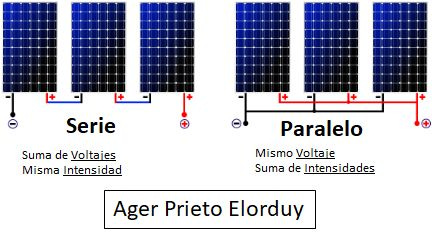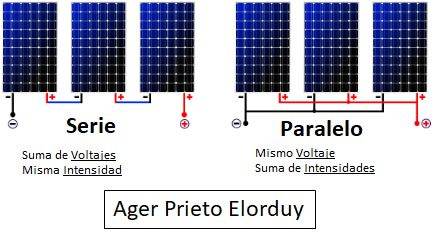64)Autoabastecimiento energético: Placas fotovoltaicas en casa.
Tras un gran letargo, parece que los paneles solares están entrando en nuestras vidas y por ende, en nuestras viviendas. Puede parecer sorprendente que países como Alemania o Países Bajos sean los que dispongan mayor potencia fotovoltaica instalada per cápita en la European Union, pero esto se debe en gran medida, que ha habido incentivo para ello, cosa que en España se creó cierta inseguridad jurídica con el “Impuesto al sol” del ministro José Manuel Soria.
No obstante, las administraciones y la conciencia ambiental colectiva han convergido hoy en día, y estamos ante la eclosión de un nuevo sector. Seguidamente, voy a desgranar una instalación de una vivienda unifamiliar.
En primer lugar, debemos conocer el consumo eléctrico anual de la vivienda (p.e. 2200 kWh), de ese modo, en función de la gama de los paneles solares que instalemos, sabremos cuanta energía podremos producir en nuestro tejado como máximo.
Por poner un ejemplo, un panel solar de una gama media puede producir unos 455 W, si instalamos 6 x 455W, obtendremos una potencia máxima de 2,73 kW. En el siguiente link de PVGIS (https://lnkd.in/e6FTNa7T), podremos comprobar la radiación solar que llega a nuestro tejado.
Por otra parte, es importante diferenciar que los módulos solares pueden instalarse en serie o paralelo:
-Si instalamos en 𝐒𝐄𝐑𝐈𝐄, el polo positivo de un panel se conecta al polo negativo del siguiente panel, siendo la suma de los voltajes de los módulos y manteniendo la intensidad de corriente.
No obstante, si un panel se estropea, por cualesquiera que sea el motivo, el sistema nos dará un voltaje máximo que corresponde a ese panel estropeado, pudiendo ser 0.
-Si instalamos en 𝐏𝐀𝐑𝐀𝐋𝐄𝐋𝐎, por un lado conectaremos todos los polos positivos de los módulos, y por el otro, conectando todos los polos negativos. De esta forma, se mantiene el voltaje de los paneles solares, mientras que se suma la intensidad.
Realmente, con esta configuración las placas actúan individualmente, evitándonos problemas si surge algún malfuncionamiento en alguna de ellas, pero para ello, deberemos de poner un mini-inversor en cada módulo, encareciendo el proyecto.
-¿Cuál es la mayor desventaja?
La producción solar tiene un rango de acción aproximado de 9 a 18h, y justamente, durante esa franja horaria la casa se encuentra, mayormente, inhabitada, ya que los miembros de la familia están trabajando o estudiando. En ese caso, el grado de aprovechamiento es bastante limitado, ya que cuando nos despertamos y al anochecer, es decir, cuando mayor es la actividad en la casa, no podremos utilizar el recurso solar, y tendremos que consumir la energía de la red convencional. Es por ello, que la opción de las 𝙱𝙰𝚃𝙴𝚁Í𝙰𝚂 gana enteros.
En el siguiente post analizare el dimensionamiento de la batería para intentar ser autosuficientes, adelanto, no será barato. ;)
64) Energy self-sufficiency: photovoltaic panels at home.
After a great lethargy, it seems that solar panels are entering our lives and therefore, our homes. It may seem surprising that countries like Germany or the Netherlands are the ones with the highest installed photovoltaic power per capita in the European Union, but this is largely due to the fact that there has been an incentive to do so, which in Spain created some legal uncertainty with the "Sun Tax" of Minister José Manuel Soria.
However, the administrations and the collective environmental conscience have converged today, and we are facing the emergence of a new sector. Next, I am going to describe an installation of a single-family home.
First of all, we must know the annual electricity consumption of the house (for example, 2200 kWh), in this way, depending on the range of solar panels that we install, we will know how much energy we can produce on our roof as a maximum.
To give an example, a mid-range solar panel can produce about 455 W, if we install 6 x 455W, we will obtain a maximum power of 2.73 kW. In the following PVGIS link (https://lnkd.in/e6FTNa7T), we can check the solar radiation that reaches our roof.
On the other hand, it is important to differentiate that solar modules can be installed in series or parallel:
-If we install in 𝐒𝐄𝐑𝐈𝐄, the positive pole of one panel is connected to the negative pole of the next panel, being the sum of the module voltages and maintaining the current intensity.
However, if a panel breaks down, for whatever reason, the system will give us a maximum voltage that corresponds to that broken panel, which can be 0.
-If we install in 𝐏𝐀𝐑𝐀𝐋𝐄𝐋𝐎, on the one hand we will connect all the positive poles of the modules, and on the other, connecting all the negative poles. In this way, the voltage of the solar panels is maintained, while the intensity is added.
Actually, with this configuration, the boards act individually, avoiding problems if a malfunction occurs in any of them, but for this, we must put a mini-inverter in each module, making the project more expensive.
-What is the biggest disadvantage?
Solar production has an approximate range of action from 9 a.m. to 6 p.m., and precisely during that time slot the house is mostly uninhabited, since family members are working or studying. In this case, the degree of use is quite limited, since when we wake up and at dusk, that is, when the activity in the house is greater, we will not be able to use the solar resource, and we will have to consume energy from the conventional network. . That is why the option of the 𝙱𝙰𝚃𝙴𝚁Í𝙰𝚂 wins integers.
In the next post I will analyze the sizing of the battery to try to be self-sufficient, advance, it will not be cheap. ;)





